It was a rematch of the World Cup 2018 final, as each team came into the game with the hope of improving upon their disappointing performances over the weekend.
France claimed a hard-fought 1-0 victory against a resolute Swedish side, but the performance was widely regarded as below expectation. Meanwhile, Croatia was in Portugal, suffering a 4-1 embarrassment, conceding 27 shots while recording five of their own, with just two making it to the target.
In this tactical analysis, we’ll look at the finals rematch, breaking down France’s use of the half-spaces and each team’s issues when building out of the back. This analysis will also take a deeper look into Croatia’s issues in attack, deconstructing Zlatko Dalić’s attacking tactics to figure out where Croatia is going wrong.
Lineups
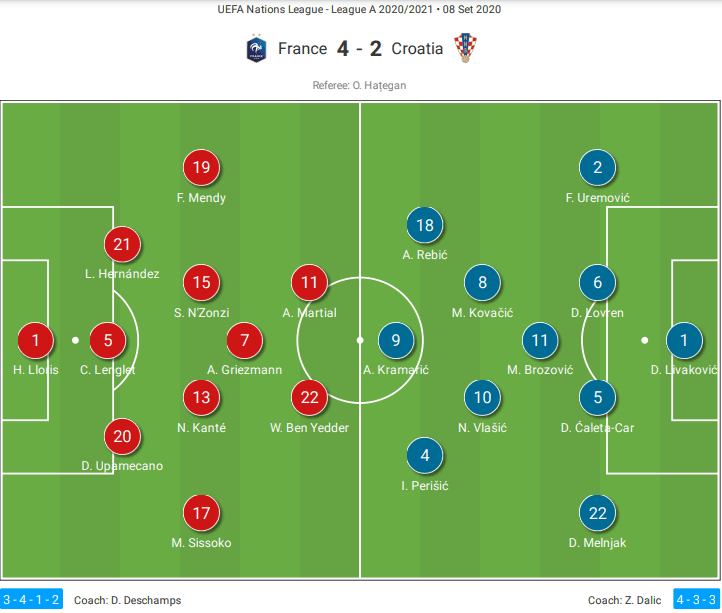
Coming into the international window, Didier Deschamps evaluated the personnel at his disposal and decided to field a 3-4-1-2. Hugo Lloris made the start in goal with a back three of Dayot Upamecano, Clément Lenglet, and Lucas Hernández. Moussa Sissoko and Ferland Mendy provided the formation’s width while N’Golo Kanté and Steven Nzonzi were the two ball-winners in the middle of the midfield. Antoine Griezmann played just beneath Wissam Ben Yedder and Anthony Martial, interchanging with his two forwards to get behind the Croatian defence.
Dalić’s side was coming off a 4-1 defeat at the hands of a Cristiano Ronaldo-less Portugal and looking to leave the international break with some positive momentum. In their 4-3-3, Dominik Livaković started in goal with Filip Uremovic, Dejan Lovren, Duje Ćaleta-Car, and Dario Melnjak forming the backline. Marcelo Brozović was the point man with Mateo Kovačić and Nikola Vlašić ahead of him in midfield while Ante Rebić, Andrej Kramarić, and Ivan Perišić were the forwards.
Among the interesting features in the way the approaches played out were France’s use of the right-sided players to create width, Croatia’s left-sided overload, and the narrowness of each team. The starting position map below lets us know the average starting point where each player took their first touch.
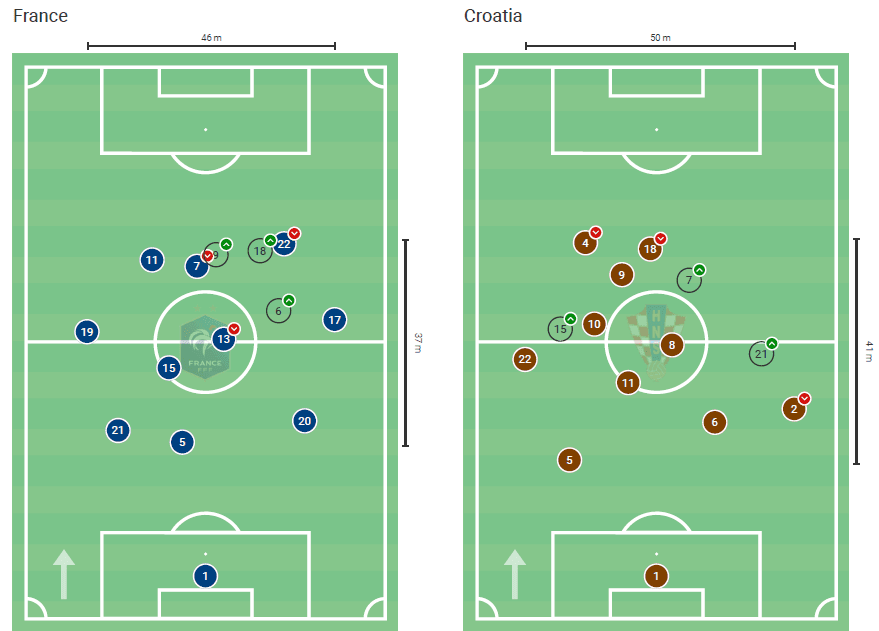
You’ll see how these positions impacted the gameplay and outcome, starting first with France’s use of the half-spaces.
France exploited the half-spaces
Much like the World Cup 2018 final, France came into this match willing to concede possession and use direct attacking tactics. With personnel issues impacting his squad selection, Deschamps switched from a 4-3-3 to a 3-4-1-2. This change in formation allowed Griezmann to nominally play underneath the two forwards.
I say nominally because it was frequently Martial and Ben Yedder who dropped into the midfield to receive. One of the more fluid uses of the formation was the interactions of the three highest players. As Martial and Ben Yedder dropped into midfield, Griezmann would take note of whether the defender went with his teammate and run into the space they vacated. That allowed France to consistently get behind the Croatian backline, leading to their 12 shots (six on target) and 3.01 xG, which shows the relative quality afforded on the shooting opportunities.
Though the three highest players spearheaded the attacks on goal, the rest of the team was quick to contribute. Sissoko was especially active on the right wing and Kanté offered a nice threat from a deeper starting point. Martial’s holdup play, in particular, was a catalyst for the midfield’s attacking participation.
In the image below, Martial dropped into the midfield, cueing Griezmann to make a run into the left half-space. With Brozović forced to pick up Martial and Vlašić slow to pick up the run of Kanté, the Chelsea man ran into the open space in the middle.
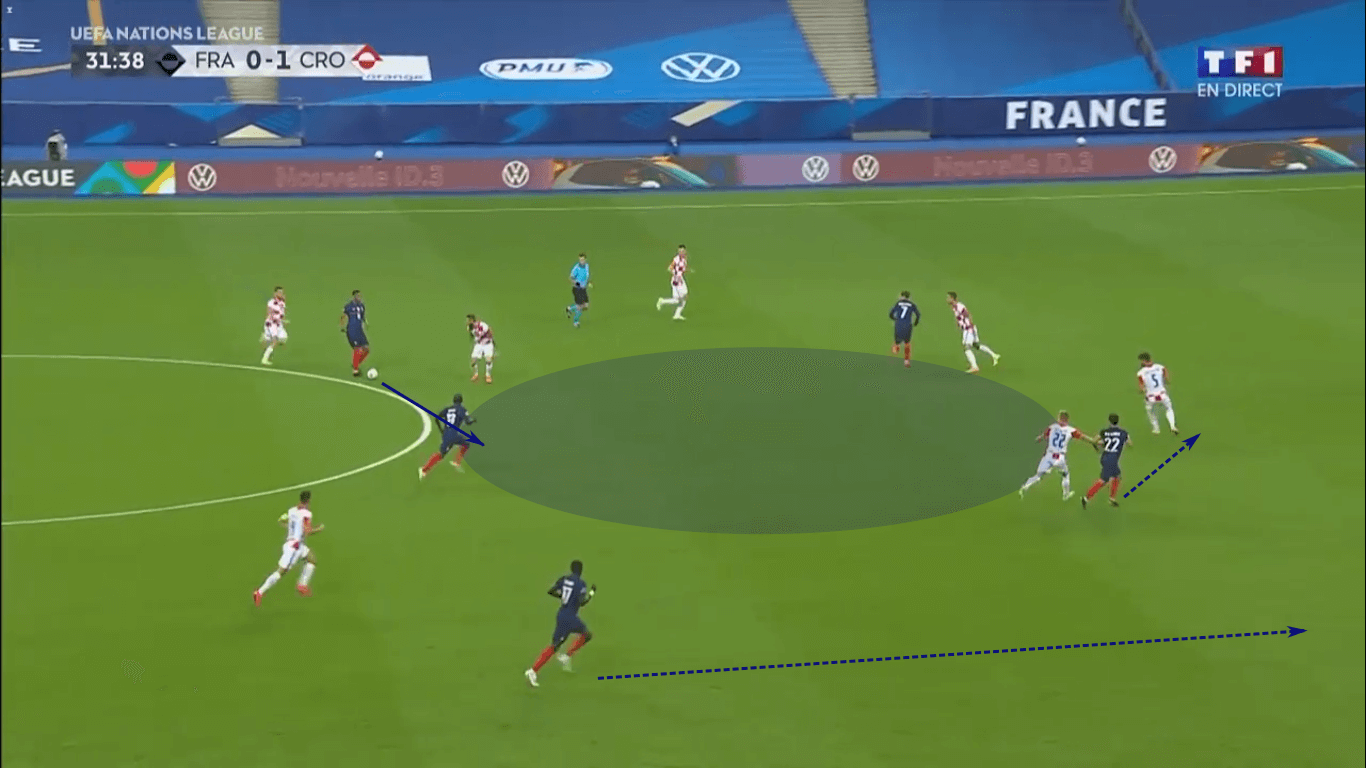
Meanwhile, Sissoko had a step on Perišić. Ben Yedder intelligently pulled Melnjak into the central channel, opening up the half-space and wing for Sissoko. With the Croatian defence forced to deny the central channel to France’s forwards, as well as the oncoming run of Kanté, Sissoko pushed forward.
With Sissoko left alone on the right, Kanté played him, setting his teammate up for a first-touch cross. Circling back to Ben Yedder, we saw him peel away from Melnjak, but stay ahead of Ćaleta-Car. This is a great example of anticipating the pass out wide and, essentially, preventing himself from being marked by the centre-back as it was Ćaleta-Car who was ultimately responsible for picking up the runner into the box.
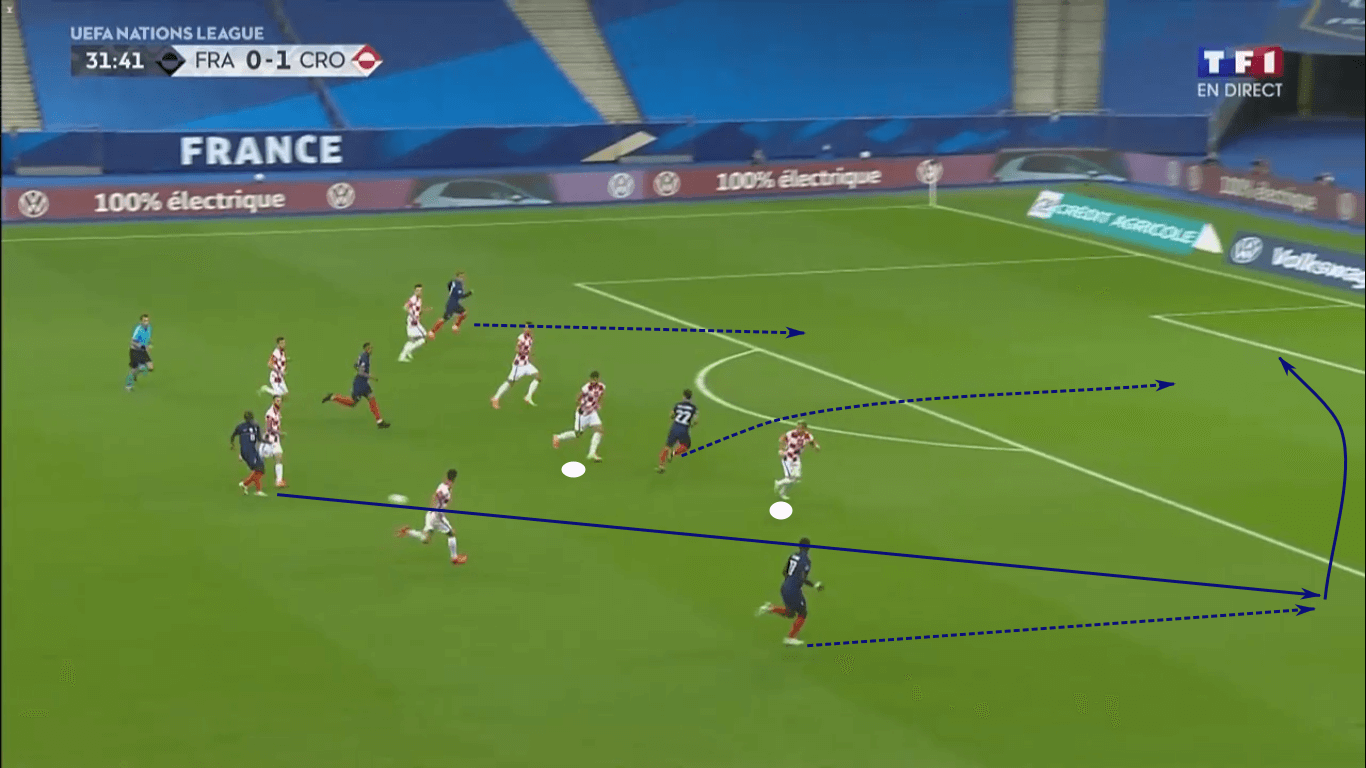
France only sent seven crosses on the night and managed to complete just one. While it wasn’t the preferred route to goal, early crosses did present opportunities, much like we saw in the previous example.
However, the area where France were most effective was in the half-space interchanges of the forwards. Much like the previous sequence, the one below shows Martial driving the attack forward from the central channel. He and Griezmann are 2 v 2, so the Barcelona man runs into the left half-space to clear the central channel for Martial.
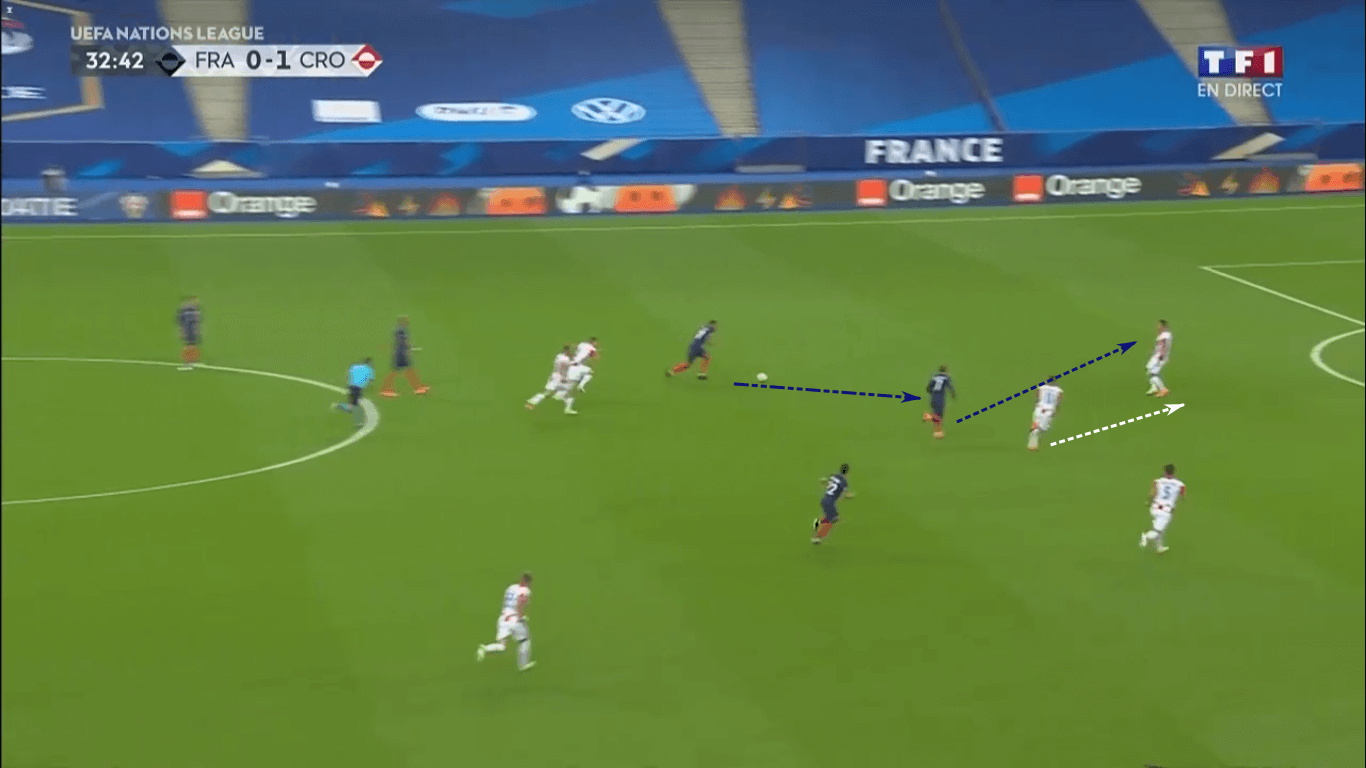
Martial intelligently pins Lovren, catching his Liverpool rival on his heels. Rather than cutting inside into the cover defender, Martial slipped a pass to Griezmann. The shot nearly resulted in a French goal, but Livaković made a fantastic save.
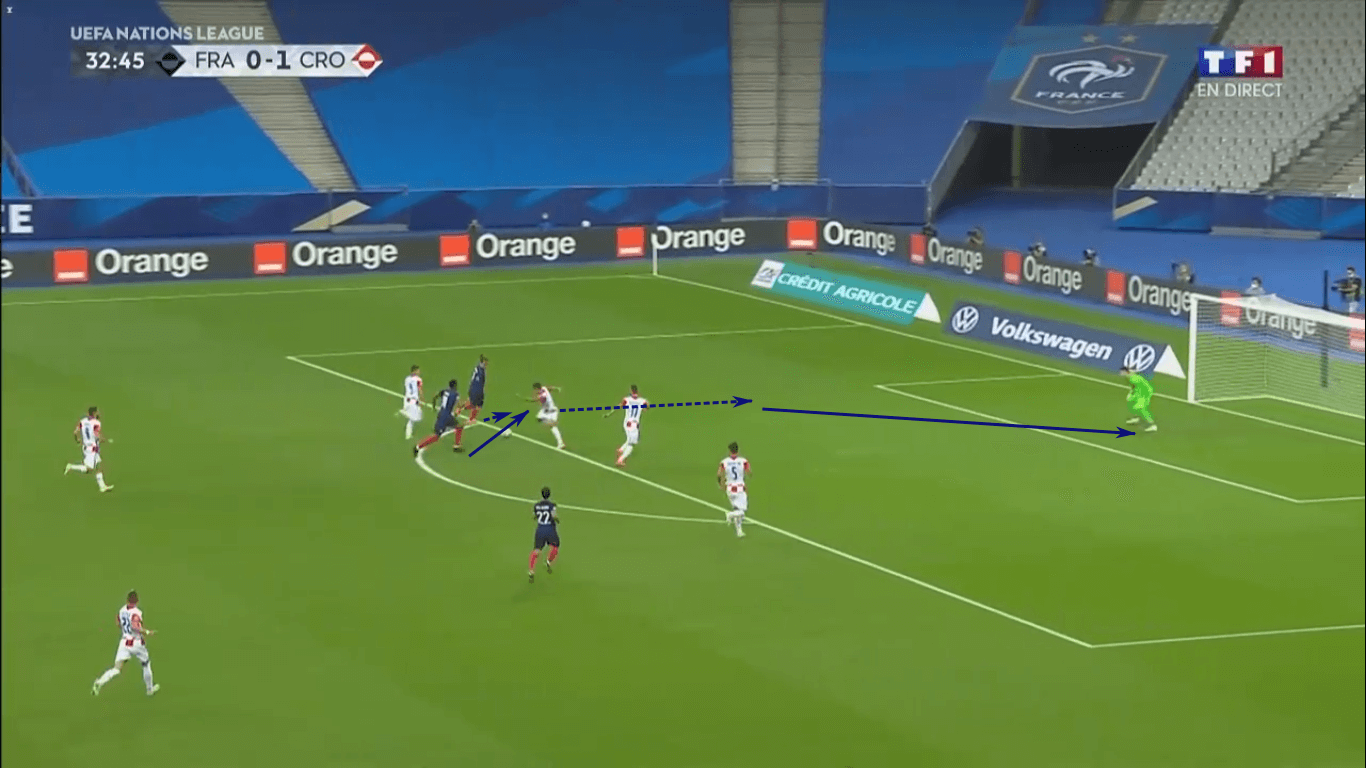
Without the pace of Kylian Mbappé, Deschamps found a system to keep the Croatian defence off balance. A willing runner like Griezmann teaming up with highly technical and intelligent players like Martial and Ben Yedder allowed France to attack more directly and unlock this struggling Croatian defence.
Both sides struggled to play out of the back
Despite the talent on the pitch, each side struggled to play out of the back. Croatia’s issues in breaking down the French press forced them into 50 long passes, 33 of which were successful (66%).
It’s not the completion percentage that was the issue as much as it was the sheer volume of long passes. In most cases, the approach was one of “hit and hope” in the direction of a forward. The issue is that all three of France’s centre-backs, as well as the 1.96 m Nzonzi, are all excellent aerial defenders.
France’s success in the defensive phase was largely down to the man-marking approach of Griezmann and the forwards. Looking at the sequence below, Griezmann and Martial are tightly marking Brozović and Lovren respectively while Ben Yedder is within range of Ćaleta-Car. With the French midfield taking away the intermediate-range options, Livaković was forced to play long.
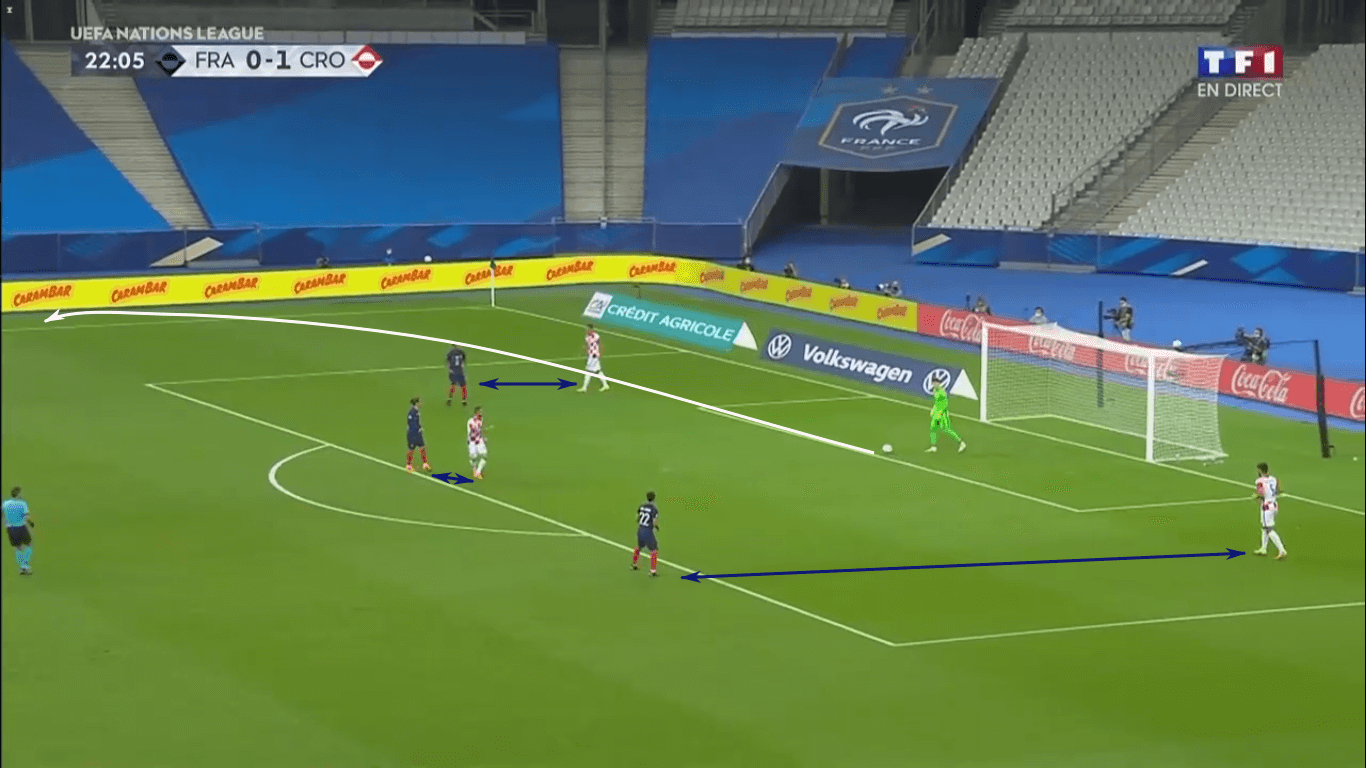
Upamecano was always the favourite against Perišić, winning the header and putting it in the direction of Kanté. After a brief battle, he and Nzonzi claimed possession, ending the Croatia attack.
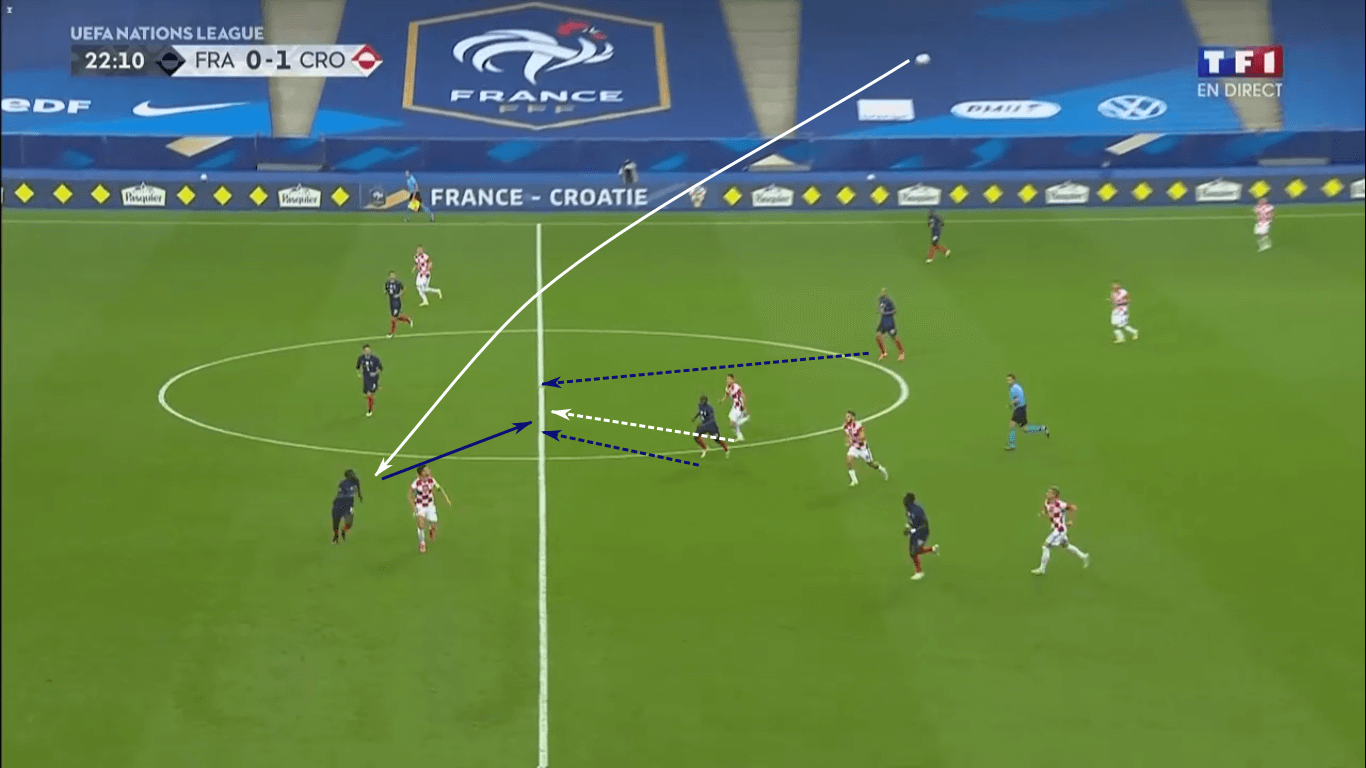
Our example from above shows the most commonly deployed of Croatia’s tactics against the French high press. While they didn’t always resort to the long ball, the side really struggled to play out of pressure on the ground.
Up against the man-marking high press, Croatia’s additional player was the goalkeeper, Livaković. As France pushed Croatia closer to goal, they essentially eliminated him for the play. With Lovren under heavy pressure, Brozović checked deep to offer an option. He sent Lovren’s pass in the direction of Uremovic, but Mendy read the play well and outpaced his mark to the ball.
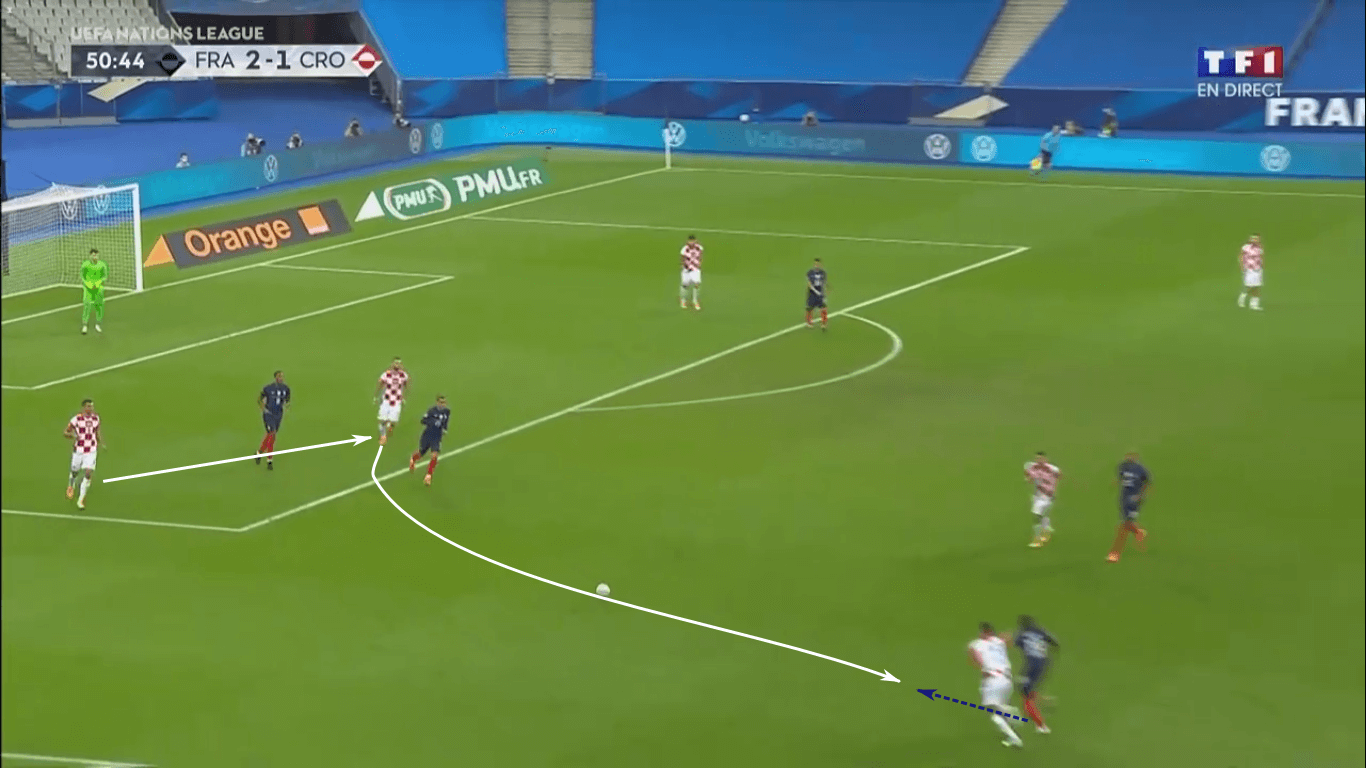
This was no isolated incident either. Croatia, while wanting to play from the back to draw out Deschamps’ defence, didn’t manage the pressure well, rarely breaking the lines and maintaining possession. In the few instances they were successful, the side did manage to create scoring opportunities, but there was far too little success in this part of the game.
For the game, France had 16 low losses to Croatia’s 14, though that didn’t have too much of an impact on France’s approach. The defending World Cup champions kept it simple when playing out of the back, preferring to use the wings or attempt to play the high targets to progress. In fact, the miscues tended to come from rather simple passes and sequences, a few of which gifted Croatia scoring opportunities.
In their defence, Croatia’s high press did make the pitch horizontally compact. They let France pass among the backline, looking for poor first touches and body orientation to cue pressure. If France was guilty of anything in this match, it was sloppy build-outs, particularly in those two areas. Each member of the backline was caught on a few occasions, with Lenglet having five low losses, Hernández chipping in another four, and Upamecano with three. Sissoko was especially sloppy in this game, recording an astonishing 20 losses, three coming in his own half.
The example below highlights some of the issues. In this instance, it’s Upamecano receiving the ball with a closed body orientation. His only passing options are Lloris and Lenglet, but Rebić is well-positioned to press passes to either of them. A quick sequence from Lenglet to Kanté, followed by a switch to Hernández might have played them out of pressure, but you can sense the concern of a turnover.
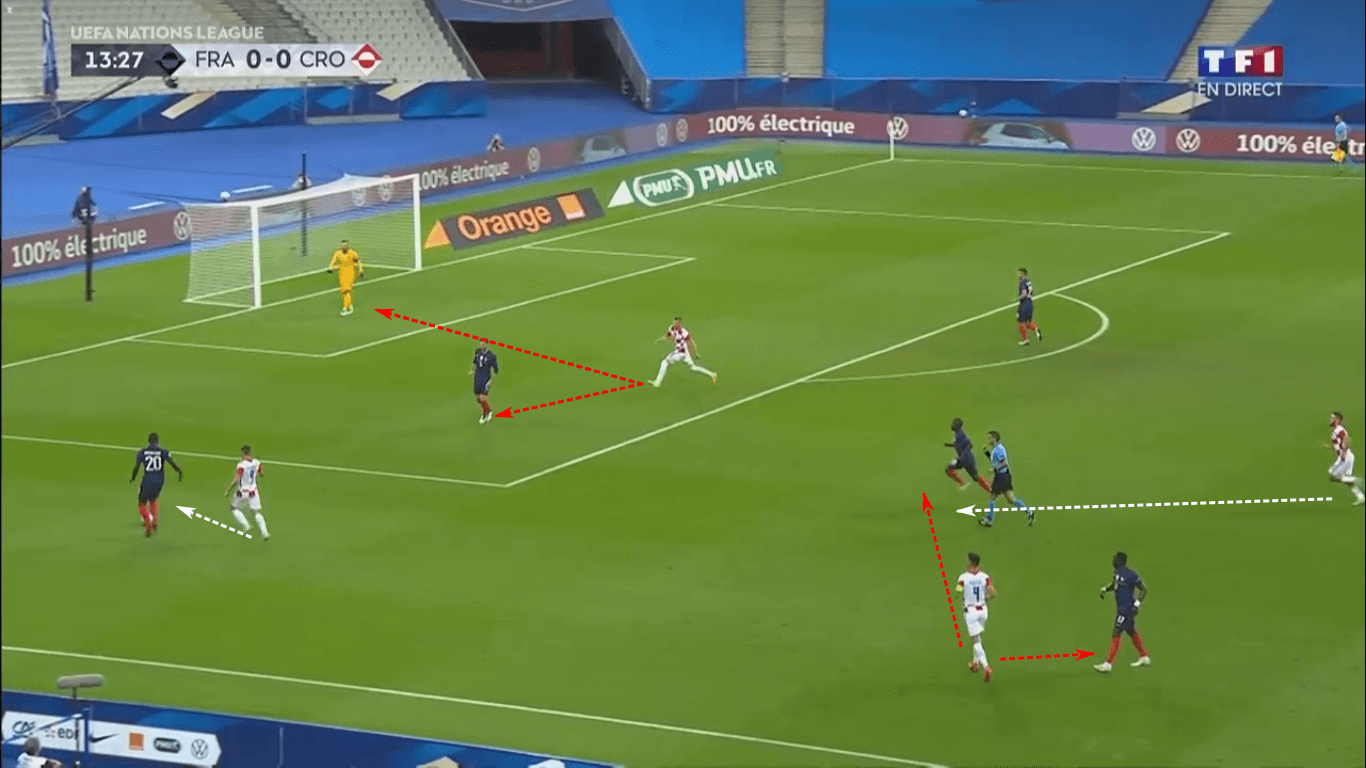
His best course of action was to draw contact and try to pick up the foul, but the lack of contact from Kramarić lulled him into holding the ball longer. With each passing second, the window to play out to Lenglet became smaller.
In the end, Upamecano took an awkward touch, almost trying to stop himself from passing to Lenglet. With the touch, Kramarić gained possession and passed the ball to Rebić. The right-forward heard footsteps and dummied, but those footsteps belonged to Hernández, who regained possession for his side.
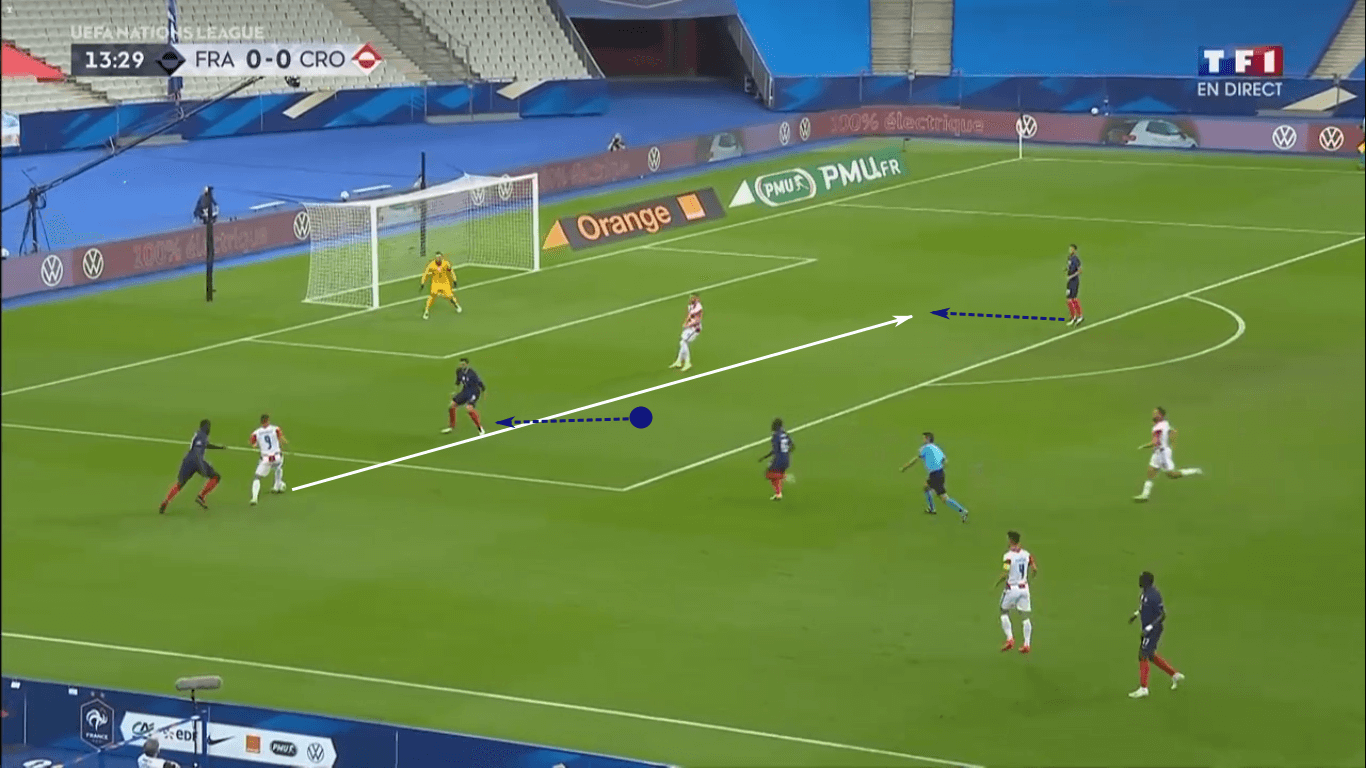
It was a golden opportunity in the early stages of the match, coming from a sloppy action from the French backline. Though they entered the game looking to concede possession and play more directly, the inability to cleanly play out of the back nearly cost them on a few occasions. It’s an area this side will have to clean up before the Portugal game.
Croatia’s attacking issues
Early in the analysis, the starting position map showed a left-sided overload from Croatia. With roughly seven of the ten field players starting on the left half of the pitch, the objectives were to either play through the French press on the left or switch play into the open spaces on the right.
The issue is that Uremovic, who often plays centre-back, didn’t offer much in attack. That space on the right side of the pitch was wasted as Croatia rarely looked to use it. For the match, 16 of their open attacks came down the left third of the pitch, 12 through the centre, and just eight from the right. Of their 0.60 xG, a measly total of 0.10 came from attacks on the left, 0.11 from the right, and 0.38 came through the centre.
While the side tried to use their left-sided numbers to overpower France, Perišić, Vlašić, and Melnjak were largely held in check. Brozović would often shift to his left to assist in the build-up, but the Inter Milan man only managed to draw more French bodies to the left, making it extremely difficult for Croatia to play out of pressure, especially given the inaccessibility of the outlets.
In the example below, Croatia have six outfielders in the left wing and half-space. Lovren is available for the deep drop and Uremovic is in the right wing. Josip Brekalo, who replaced Rebić at halftime, was making his run into the central channel, a tactic Croatia utilised throughout the second half, leaving Brozović with just two options on the right side of the pitch.
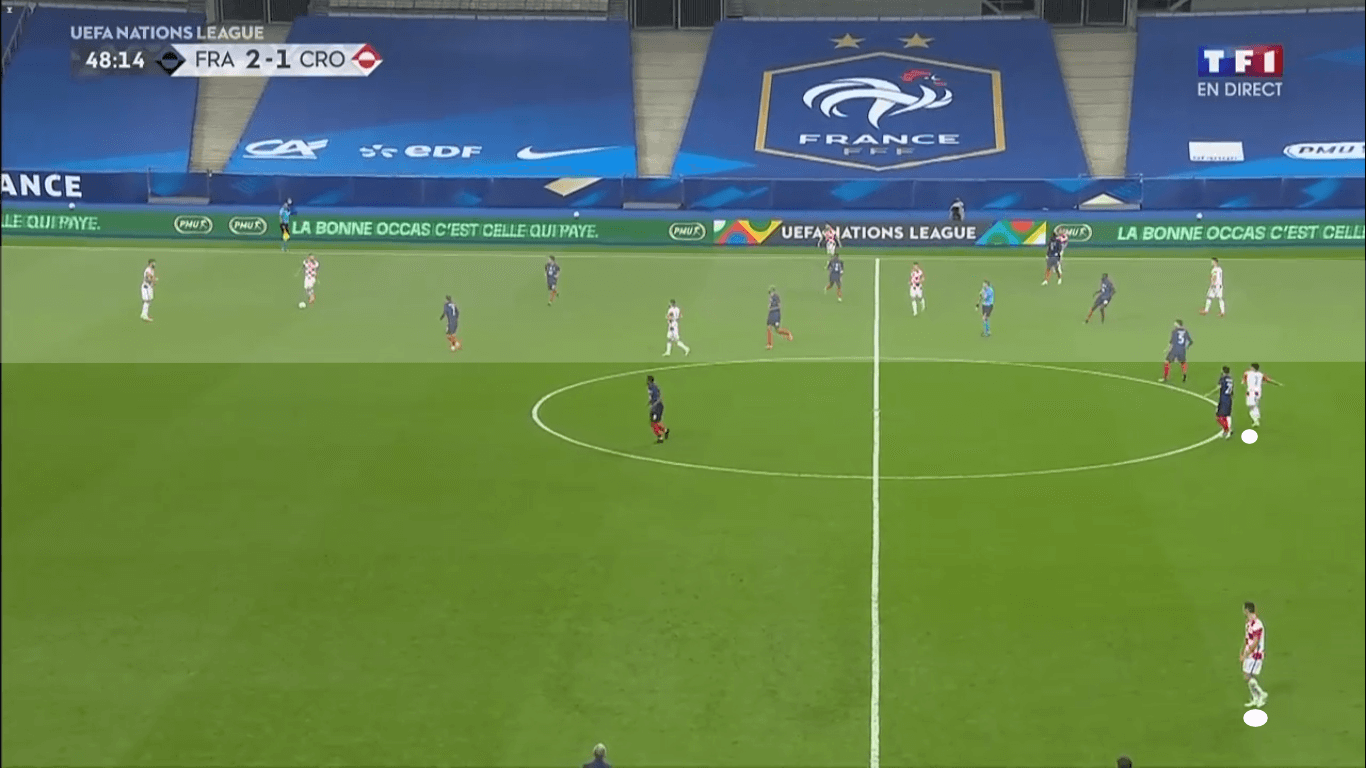
Perišić was the one real width provider for the World Cup runners-up. Despite his quality, he didn’t complete any of his five crosses. For the match, Croatia sent 11 crosses, completing just two for an 18% success rate. One of the issues was the lack of numbers in the box. 59% possession didn’t translate into well-structured attacks with excellently timed crosses.
Our image below gives a standard glimpse of Croatia’s crosses. As Perišić released the cross, he had just one teammate in the box against four French defenders.
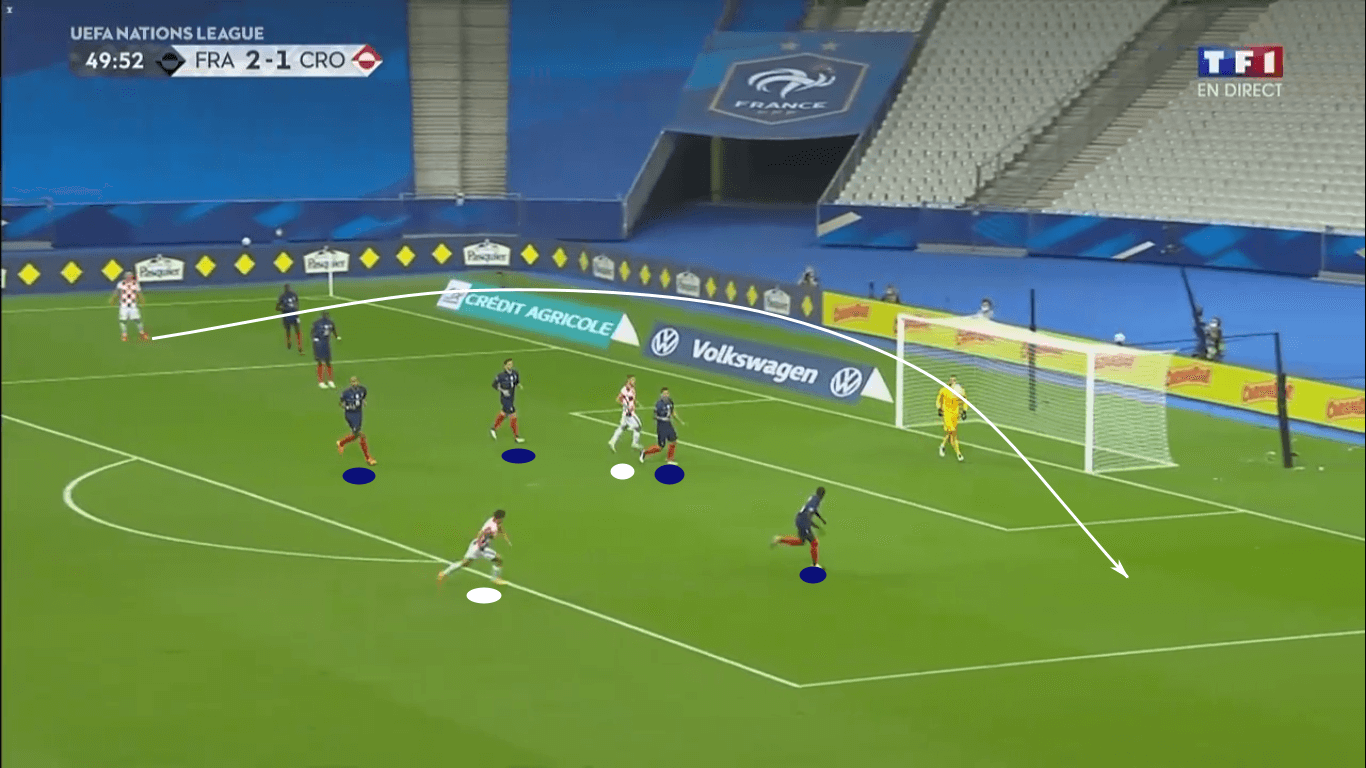
The first of the issues was Croatia’s rush in sending the crosses. They weren’t on, but the passes were sent anyway. Secondly, far too few players, especially from the midfield, were high enough to offer a reasonable option going forward, either in meeting a cross or through central combinations. It was the isolated, disconnected forwards who were left to do the work.
That leads one to ask what Dalić wanted from his midfield. Brozović ran the show from deep, but Kovačić and Vlašić were underutilised. Vlašić often engaged in those left-sided overloads, drawing matchups against Kanté and Sissoko.
Kovačić, as seen below, was often positioned in front of Hernández. If Nzonzi moved to his right to help with the overload, Hernández was often forced to take a few steps into the midfield to offer pressure on Kovačić. When that happened, paired with a passing lane to Brekalo, Croatia would try the intermediate-range through ball.
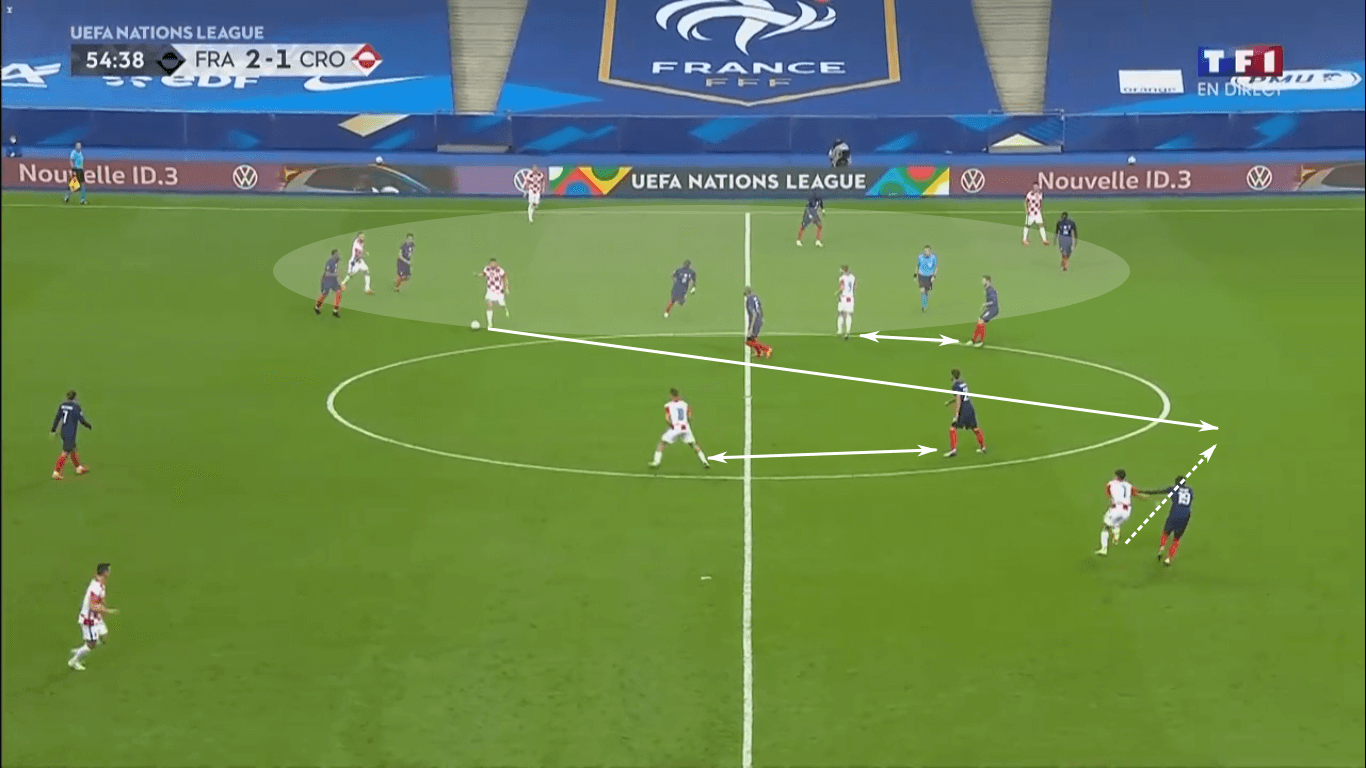
While it worked on Croatia’s second goal, Kovačić was largely a passenger in this match. Dalić was largely to blame in that regard, not carving out a suitable role for the Chelsea man.
One of Croatia’s other issues is their poor rest defence and transitional to defence, both of which stem from their attacking tactics. This match exposed the gaps left behind the full-backs, especially on the left. With the numbers high up the pitch marked, Melnjak was often asked to progress play via the dribble.
However, as seen in the sequence below, France used his dribble as a pressing trap, cutting out his passing options and intensely pressuring the Çaykur Rizespor defender. Notice the French forwards lying in wait for the turnover.
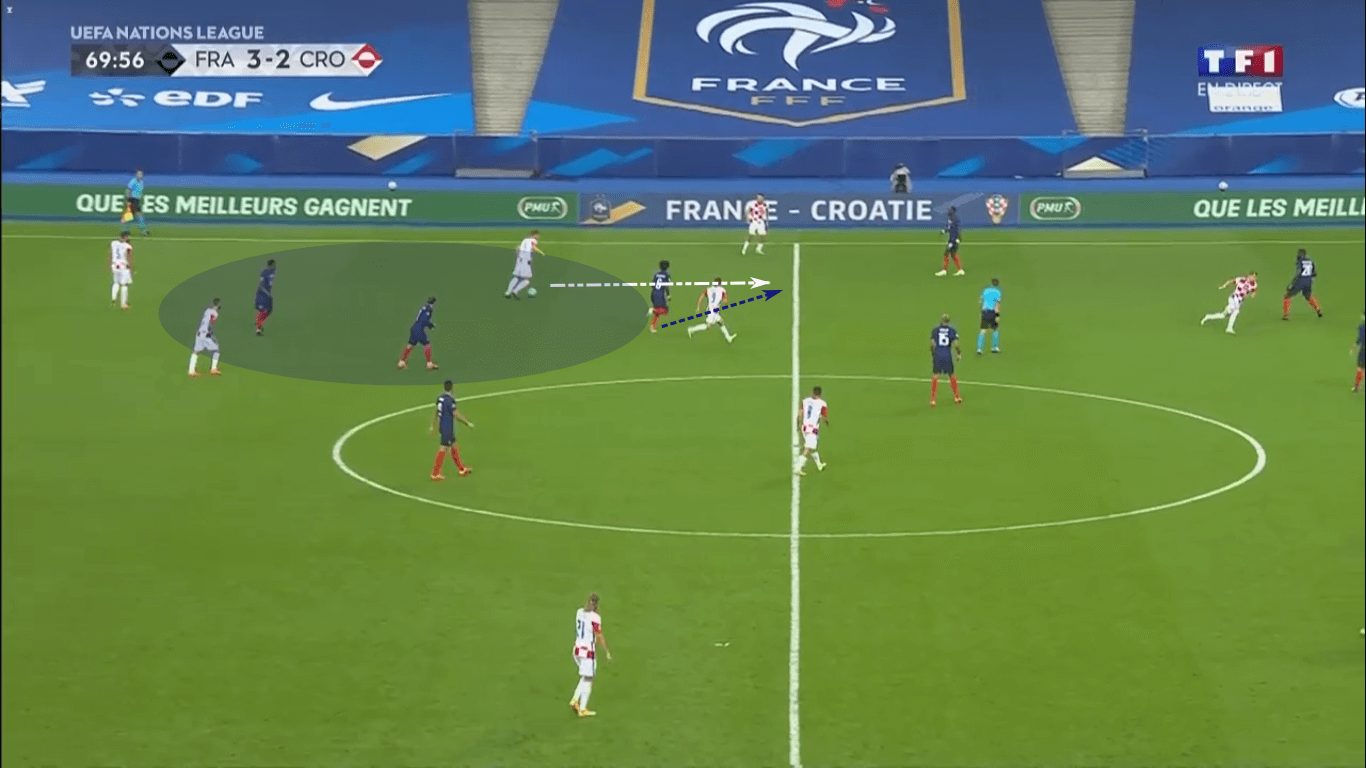
Eduardo Camavinga, who became the youngest French debutant since 1914, put in the tackle to win the ball. From there, France raced to goal with a 4 v 3 advantage, culminating in a shot from Camavinga. In his brief spell on the pitch, the young Frenchman showed why he’s linked with Real Madrid, as he was an absolute handful for the Croatian defence.
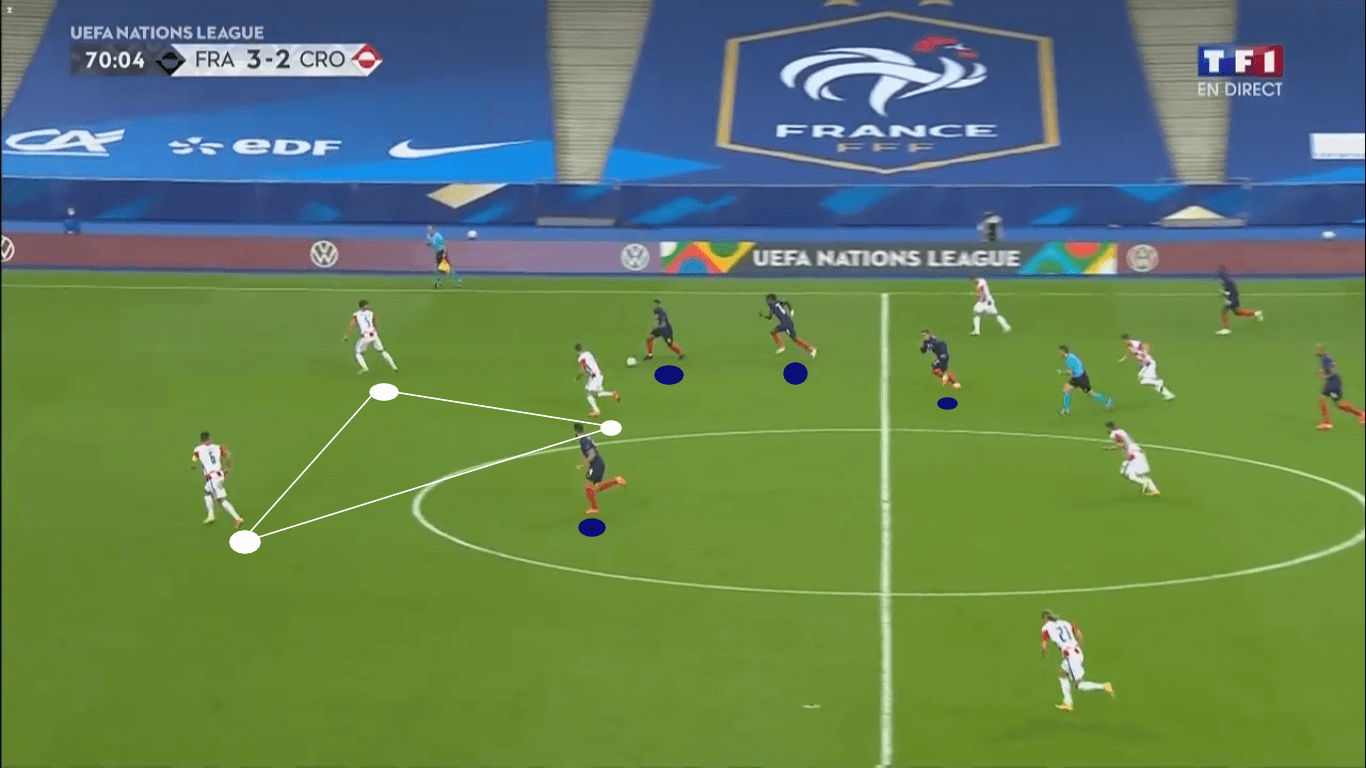
Missing Rakitić and Modrić certainly didn’t help matters, but this Croatian side was some distance from their World Cup 2018 performance. Issues in attack, combined with a leaky defence, doomed them to a winless start in the 2020/21 UEFA Nations League.
Conclusion
While it wasn’t the most fluid performance, France managed to end the international break with another win, scoring four times in the process. Deschamps also managed to issue a debut to a young star and incorporate players who have been on the fringes of the team for the past few years. If Mbappé, Varane, and Pogba are ready for the Portugal matchup in October, we’ll likely see a different system, but the same direct attacking that his side has used since their Euro 2016 defeat to Portugal.
As for Croatia, they too had a few key members out of the team, but they’ll still be disappointed with the two results. Conceding eight goals and having little attacking threat led to two subpar displays. They’ll face Switzerland in a friendly, then host a disciplined Swedish team when the UEFA Nations League resumes. Dalić has his work cut out for him, especially if those key players don’t return for the next round of games.




Comments